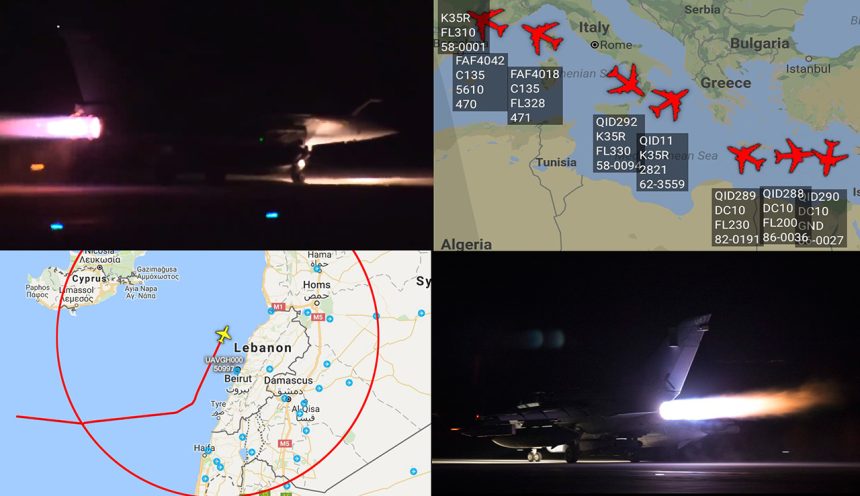Syria Air War Day 1 explained.
In the night between Apr. 13 and 14 aircraft from the U.S., UK and France launched a first wave of air strikes against ground targets in Syria. What follows is a recap based on OSINT (Open Sources Intelligence) since most of the aircraft involved in the raids could be tracked online via information in the public domain.
The “limited” action was preceded by intelligence gathering activity carried out by many of the assets that have been flying over eastern Mediterranean Sea lately. The first sign something was about to happen was the unusual presence of an RQ-4 Global Hawk drone tracking off Lebanon and Syria few hours before the first stand-off weapons landed on Syrian regime’s chemical sites/infrastructure.
15 Hours after departure from NAS Sigonella – FORTE10 continues to carry out it’s task in the Eastern Mediterranean West of Lebanon & Syria at 56,000 feet pic.twitter.com/GNxchRISyE
— Aircraft Spots (@AircraftSpots) April 13, 2018
The RQ-4, callsign “Forte 10” flew for several hours west of Lebanon, likely pointing its IMINT and SIGINT/ELINT sensors at the Syrian Air Defense batteries in heigthened readiness status. The drone then moved southwest, north of Egypt where it was joined by an RC-135V callsign Fixx74. It was about 23.20 GMT and it looked like the two ISR platforms, after collecting intelligence from a close position, were making room for the incoming bombers.
Currently taking a narrow view pic.twitter.com/ngGytNLPTV
— Manu Gómez (@GDarkconrad) April 13, 2018
Here’s the position of Fixx74.
USAF RC-135V 64-14846 FIXX74 departed Souda Bay – On task over the Eastern Mediterranean North of Egypt pic.twitter.com/N0xPd0tiCH
— Aircraft Spots (@AircraftSpots) April 14, 2018
Among the aircraft coming in to conduct their bombing run from the Med, there were French Air Force Dassault Rafale jets from Saint Dizier AB, France, supported by C-135FR tankers and RAF Tornado GR4s with their Storm Shadow missiles, which launched from RAF Akrotiri, Cyprus. Whilst they did have their transponder turned off, the presence of the bombers and their accompanying tankers was leaked by their radio communications with civilian ATC agencies, such as Athinai ACC, that took place on unencrypted VHF frequencies broadcast on Internet on LiveATC.net.
Interestingly, at least two packages of fighters (each supposed to include 4x F-16Cs from 31FW and 4x F-15Cs from 48FW loaded with air-to-air missiles – actually, the second one included only 3 Vipers instead of 4) supported by KC-135 tankers, provided DCA (Defensive Counter Air) cover to the bombers and to the warships launching TLAMs.
After the first waves of attacks, that involved also U.S. Air Force B-1s from Al Udeid, another Global Hawk drone was launched from Sigonella, to perform BDA (Battle Damage Assessment).
USAF RQ-4B 11-2047 FORTE11 departed Sigonella at 2335z – On task West of Lebanon & Syria likely conducting a Post Battle Damage Assessment task pic.twitter.com/O5e9UYJv3w
— Aircraft Spots (@AircraftSpots) April 14, 2018
The air strikes required a huge tanker support. There were 7 KC-135 and KC-10 tankers airborne over Southern Europe heading to the eastern Mediterranean Sea: something unusual for a Friday night. At the time of writing, there are 13 (!) tankers up: some are dragging the second package of U.S. F-15s and F-16s back to Aviano, whereas others are repositioning to RAF Mildenhall or Souda Bay after a night of operations:
UPDATE 2: 13 tankers now up this morning QUID290+291 KC-135’s abeam Lyon QUID292+295 Sicily QUID21 Adriatic QUID282+283 +QUID11 Southern Italy QUID288/289/290 KC-10’s near Cyprus & FAF4018/4042 @planesonthenet @KalteMalte53 @ItaMilRadar @Andy007_SR_A @Su39frogfoot @cencio4 pic.twitter.com/8w6yKan82p
— Buzz 🏴 (@Buzz6868) April 14, 2018
USAF McDonnel Douglas KC-10A (86-0027) departed from Souda Bay AB making aerial refueling mission between Crete and Cyprus#SyriaStrike #Syria pic.twitter.com/fCAj1f9nHW
— ItaMilRadar (@ItaMilRadar) April 14, 2018
Another interesting aircraft tracked online in the aftermath of the raid, is a Bombardier E-11A 11-9358 from 430th EECS stationed at Kandahar Afghanistan. The aircraft is a BACN (battlefield airborne communications) asset: BACN is technological “gateway” system that allows aircraft with incompatible radio systems and datalinks to exchange tactical information and communicate. By orbiting at high-altitude, BACN equipped air assets provide a communications link between allies, regardless of the type of the supporting aircraft and in a non-line-of-sight (LOS) environment. The BACN system is also deployed onboard EQ-4B Global Hawk UAVs. Although we can’t be completely sure, it is quite likely that the aircraft was involved in the air strikes as well, providing data-bridging among the involved parties.
VELCR04 – 43,000ft over the Czech Republic
🇺🇸 US Air Force
E-11A 11-9358 pic.twitter.com/X8gfFrnn3q
— CivMilAir ✈ (@CivMilAir) April 14, 2018
In the end, thanks to ADS-B, Mode-S and MLAT we got a pretty good idea of what happened during the first wave of air strikes on Syria. It’s obviously not complete, still quite interesting.
H/T to @AircraftSpots @Buzz6868 @CivMilAir @GDarkconrad @ItaMilRadar @planesonthenet and many others for providing details, hints, links and what was needed to prepare this article. You guys rock!








